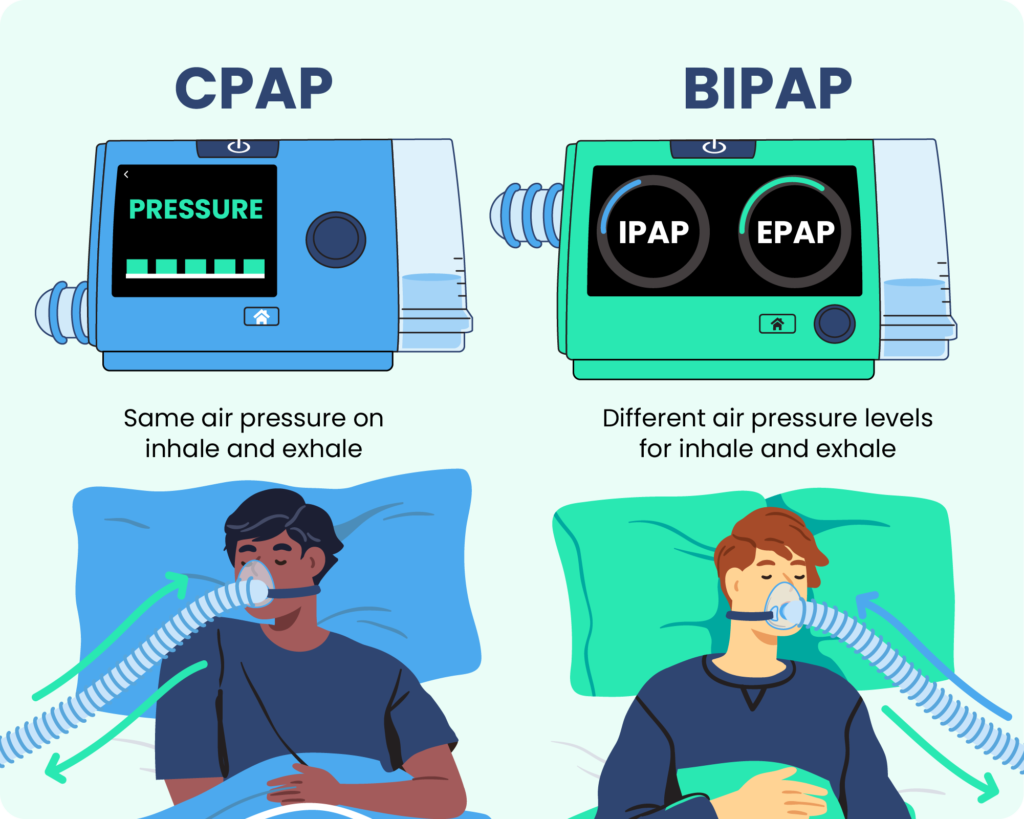Choosing the Right BiPAP Rental Package for Your Needs
Choosing the Right BiPAP Rental Package for Your Needs
Blog Article
Bipap vs. CPAP: Which Is the most effective for Your Sleep Disorder?
When browsing the complexities of sleep conditions, the choice between BiPAP and CPAP therapy is a critical consideration. Each technique uses special advantages customized to certain conditions, yet the decision depends upon individual client requirements and convenience degrees. While CPAP provides a constant airflow ideal for obstructive sleep apnea, BiPAP's double stress setups might boost convenience for those with more detailed respiratory concerns. Comprehending these differences can substantially influence therapy efficiency, leaving one to consider which alternative really lines up with their health requirements and way of life.
Recognizing Rest Disorders
Rest conditions include a variety of problems that disrupt typical sleep patterns, impacting both the high quality and duration of remainder. These disorders can show up in various forms, consisting of sleeping disorders, rest apnea, narcolepsy, agitated leg disorder, and parasomnias. Each problem presents special difficulties, commonly resulting in substantial daytime fatigue, cognitive impairment, and emotional disruptions.
Sleeplessness is defined by trouble dropping or remaining asleep, while sleep apnea entails duplicated disruptions in breathing during sleep, commonly resulting in fragmented remainder. Narcolepsy, on the other hand, is noted by too much daytime sleepiness and unexpected rest assaults. Restless leg disorder creates unpleasant sensations in the legs, motivating an uncontrollable impulse to move them, which can also hinder the capability to drop off to sleep.
The impact of rest problems expands beyond individual health, affecting total productivity, partnerships, and high quality of life. Comprehending the certain nature of each disorder is critical for efficient medical diagnosis and therapy. As rest health ends up being progressively acknowledged as an important element of general well-being, addressing these problems is vital for improving both rest top quality and daily functioning.
Just How CPAP Works
Continuous Favorable Respiratory Tract Pressure (CPAP) treatment is regularly used as a primary treatment for obstructive rest apnea (OSA) The device of CPAP entails using an equipment that supplies a stable stream of air with a mask used during sleep. This air flow preserves positive pressure in the air passage, preventing the collapse or blockage of the throat that can occur during rest.
When a person takes in, the CPAP machine offers a constant circulation of air, ensuring that the airway remains open - BiPAP Rental. This not only eases the signs and symptoms of OSA, such as snoring and interrupted rest patterns, yet additionally decreases the affiliated health risks, consisting of cardio problems and daytime fatigue
The stress settings on a CPAP maker can be personalized to satisfy private client needs, typically determined via a rest research. In general, CPAP treatment has been revealed to dramatically enhance the quality of sleep and overall health for individuals experiencing from obstructive sleep apnea.
How BiPAP Functions
BiPAP, or Bilevel Favorable Air Passage Pressure, is a customized type of non-invasive ventilation that is particularly useful for individuals with problems such as intricate rest apnea or breathing conditions. Unlike CPAP, which supplies a continuous stream of air at a single stress, BiPAP provides 2 distinctive stress settings: a greater inspiratory stress for inhalation and a reduced expiratory pressure for exhalation. This dual-pressure approach allows for simpler breathing, lowering the initiative required throughout exhalation.
The device operates with a mask fitted over the nose or mouth, linked to an equipment that generates air pressure. When the patient inhales, the equipment delivers the higher pressure to assist with air flow, ensuring that the respiratory tract stays open. Upon exhalation, the maker immediately decreases the stress, making it a lot more comfortable for the person to breathe out.

Trick Differences In Between BiPAP and CPAP

In contrast, BiPAP (Bilevel Positive Respiratory tract Pressure) uses 2 different pressure settings: one for inhalation and a lower one for exhalation. This twin stress system permits more comfortable breathing, especially for people who deal with exhaling versus a continual stress. BiPAP is commonly suggested for clients with complicated rest apnea, persistent obstructive lung condition (COPD), or those who call for added assistance during sleep.
Furthermore, the intricacy of BiPAP devices normally causes a greater cost and requires extra careful browse around these guys titration than CPAP. BiPAP Rental. Comprehending these vital differences can assist in recognizing which gadget might be better for certain rest disorders, setting the groundwork for educated therapy choices
Choosing the Right Treatment
Just how can one establish one of the most ideal therapy for handling sleep disorders? The choice between BiPAP and CPAP treatment largely hinges on the certain features of the sleep problem, the client's total wellness, and their convenience with the tool. CPAP, which provides a continuous stream of air, is commonly suggested for obstructive rest apnea (OSA) It preserves an open airway during sleep, effectively preventing apneas and hypopneas.
Conversely, BiPAP supplies two levels of stress: one for inhalation and a reduced one for exhalation. This double stress system is useful for clients with complex rest apnea or those that experience trouble breathing out against a continual pressure. Additionally, BiPAP is usually recommended for individuals with respiratory system problems, such as persistent obstructive lung illness (COPD), where varying stress setups can enhance convenience and compliance.
Eventually, a comprehensive examination by a rest expert, including a sleep study, can help figure out which treatment straightens finest with the client's demands. Elements such as convenience, convenience of use, and details medical conditions must likewise be taken right into consideration to enhance therapy end results.
Verdict
In recap, both BiPAP and CPAP offer unique objectives in the administration of rest conditions. CPAP works for obstructive rest apnea via constant air flow, while BiPAP uses twin stress setups that enhance convenience for those with intricate rest apnea or respiratory system issues. The option in between these treatments must be assisted by private requirements and problems, demanding a thorough analysis by a rest professional to guarantee optimum therapy results and improved quality of rest.

On the whole, CPAP treatment has been shown to considerably improve the top quality of sleep and general health and wellness for individuals enduring from obstructive sleep apnea.
BiPAP is commonly advised for patients with complex sleep apnea, persistent obstructive lung illness (COPD), or those who need extra more info here assistance during sleep.
CPAP is efficient for obstructive sleep apnea with regular airflow, while BiPAP provides double pressure settings that improve convenience for those with intricate sleep apnea or respiratory system concerns.
Report this page